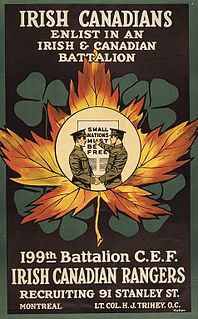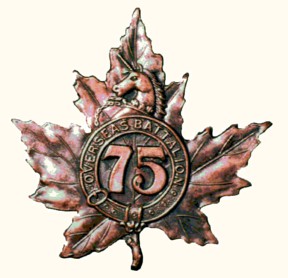Related Research Articles

The No. 2 Construction Battalion, Canadian Expeditionary Force (CEF), was raised in Nova Scotia and was one of two predominantly black battalions in Canadian military history and the only Canadian battalion composed of black soldiers to serve in World War I. Commanded by Lieutenant Colonel Daniel Hugh Sutherland, formerly of the 193rd Battalion, CEF, all but one of the unit's 19 officers were white, the exception being Captain William A. White, the unit's chaplain.

The Canadian Scottish Regiment is a Primary Reserve infantry regiment of the Canadian Army based on Vancouver Island in British Columbia.

The 20th Battalion, CEF was a unit of the First World War Canadian Expeditionary Force.
The 173rd (Highlanders) Battalion, CEF, was a unit in the Canadian Expeditionary Force during the First World War. One of a number of Highlander battalions in the Canadian Expeditionary Force, it was based in Hamilton, Ontario, and began recruiting during the winter of 1915/16.
The 123rd Battalion, Royal Grenadiers, CEF was a unit in the Canadian Expeditionary Force during the First World War. Based in Toronto, Ontario, they began recruiting in November 1915. After arriving in England, they continued to train as an infantry battalion for several months, but just before mobilizing to France in January 1917, the battalion was redesignated the 123rd Pioneer Battalion, Royal Grenadiers, CEF.

The 133rd Battalion, CEF was a unit in the Canadian Expeditionary Force during the First World War.
The 163rd (Canadien-Francais) Battalion, CEF was a unit in the Canadian Expeditionary Force during the First World War. Based in Montreal, Quebec, the unit began recruiting in late 1915 throughout the province of Quebec. In May 1916, the battalion sailed for the Imperial fortress of Bermuda, where it remained on garrison duty until late November of the same year. After arriving in England, the battalion was absorbed into the 10th Reserve Battalion on January 8, 1917. The 163rd (Canadien-Francais) Battalion, CEF had one Officer Commanding: Lieut-Col. H. DesRosiers.

The 199th Battalion, CEF was a unit in the Canadian Expeditionary Force (CEF) during the First World War.
The 216th (Bantams) Battalion, CEF was a unit in the Canadian Expeditionary Force during the First World War. Based in Toronto, Ontario, the unit began recruiting in early 1916 throughout Military District 2. After sailing to England in April 1917, the battalion was absorbed into the 3rd Reserve Battalion on April 29, 1917. The 216th (Bantams) Battalion, CEF had one Officer Commanding: Lieut-Col. F. L. Burton.

The 223rd (Scandinavians) Battalion, CEF was a unit in the Canadian Expeditionary Force during the First World War. Based in Winnipeg, Manitoba, the unit began recruiting in early 1916 in Military Districts 10, 11, 12, and 13. After sailing to England in May 1917, the battalion was absorbed into the 11th Reserve Battalion on May 14, 1917. The 223rd (Scandinavians) Battalion, CEF had one Officer Commanding: Lieut-Col. H. M. Hannesson. The battalion also had the Bohemian detachment consisting of volunteers from among Czech emigrants to Canada and the United States, who were also allowed to carry their own red and white flag.
The 235th Battalion, CEF was a unit in the Canadian Expeditionary Force during the First World War. Based in Bowmanville, Ontario, the unit began recruiting in the Spring of 1916 in Northumberland and Durham Counties. After sailing to England in May 1917, the battalion was absorbed into the 3rd Reserve Battalion on May 14, 1917. The 235th Battalion, CEF had one Officer Commanding: Lieut-Col. S. B. Scobell.

A bantam, in British Army usage, was a soldier of below the army's minimum regulation height of 5 ft 3 in (160 cm).

The 75th Battalion (Mississauga), CEF was an infantry battalion of the Canadian Expeditionary Force during the Great War. The 75th Battalion was authorized on 10 July 1915 and embarked for Great Britain on 29 March 1916. It disembarked in France on 12 August 1916, where it fought as part of the 11th Infantry Brigade, 4th Canadian Division in France and Flanders until the end of the war. The battalion was disbanded on 15 September 1920.

The 16th Battalion, CEF was a unit of the First World War Canadian Expeditionary Force. It was organized at Valcartier on 2 September 1914 in response to the Great War and was composed of recruits from the 91st Regiment Canadian Highlanders, the 79th Cameron Highlanders of Canada, the 72nd Regiment "Seaforth Highlanders of Canada", and the 50th Regiment "Highlanders".

The 10th Battalion, Canadian Expeditionary Force was a unit of the First World War Canadian Expeditionary Force (CEF), specifically in the 1st Canadian Division from 1914 to 1919. The battalion participated in every major Canadian battle of the First World War, and set a record for the most decorations earned by a Canadian unit in a single battle at Hill 70. The unit was known to its contemporaries simply as The Fighting Tenth.
The 23rd Reserve Battalion, CEF was an infantry unit in the Canadian Expeditionary Force during the First World War.
4th Battalion, CEF was an infantry battalion raised as part of the Canadian Expeditionary Force for service during the First World War. Raised in Canada in September 1914, the battalion sailed to the United Kingdom within weeks of its establishment. After a short period of training it was committed to the fighting on the Western Front, remaining in France and Belgium until the war ended. It returned to Canada in mid-1919 and after its personnel had been demobilized, the battalion was subsequently disbanded in 1920.

The 2nd Canadian Mounted Rifles Battalion, was authorized on 7 November 1914 as the 2nd Regiment, Canadian Mounted Rifles, CEF. The battalion recruited in Victoria and Vernon, British Columbia and was mobilized in Victoria. An earlier incarnation was raised for Boer War.

The 47th Battalion, CEF, was an infantry battalion of the Canadian Expeditionary Force during the Great War.

The 51st Battalion (Edmonton), CEF, was an infantry battalion of the Canadian Expeditionary Force during the Great War. The 51st Battalion was authorized on 7 November 1914 and embarked for Great Britain on 18 April 1916. It provided reinforcements for the Canadian Corps in the field until 13 November 1916, when it was reorganized as a garrison duty battalion. On 22 June 1917, its personnel were absorbed by the various regimental depots. The battalion was disbanded on 15 September 1920.
References
- ↑ Ratch, pp. 158-162
- ↑ Officers' Declaration Paper
- Meek, John F. Over the Top! The Canadian Infantry in the First World War. Orangeville, Ont.: The Author, 1971.
- Allinson, Sidney. "The Bantams: The Untold Story of World War One." London, Toronto 1981, Victoria 2005.
- Ratch, Sandra "Do Your Little Bit: The 143rd Battalion Canadian Expeditionary Force, 'BC Bantams'", in "BC Studies: the British Columbian Quarterly Number 182." Vancouver, 2014.